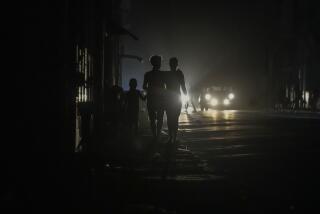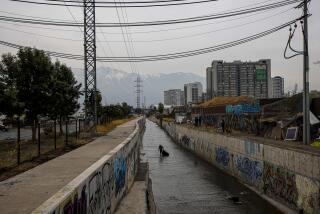Santiago counts its blessings
Reporting from Santiago, Chile — Along Jasmin Street in this capital’s middle-class Villa Olimpica neighborhood, residents were packing up their belongings in trucks Sunday, hauling out furniture, clothing and keepsakes from damaged and unlivable apartments.
Deep cracks and crooked balconies marred the 1960s-era three-story residential buildings along the quiet street, testament to the damage from the massive earthquake that struck Chile early Saturday, stunning the nation.
“It’s a lot to deal with, but at least we’re all safe,” said Carolina Jimenez, 32, a mother of two who was forced to flee her apartment as the quake struck, collapsing a wall and sending furniture flying, slightly injuring her 11-year-old daughter. “It could be a lot worse, like what happened to the poor people in the south.”
Most had by now seen television footage of the extreme damage about 125 miles to the south, where the quake and a tsunami killed hundreds of people and left tens of thousands more homeless.
The damage here in the capital was much less grave, though the sense of shock among many residents was palpable. Police say 33 people died and about 3,300 were left homeless in the capital area.
“Even though Santiago wasn’t that hard-hit, it is still a scary thing to live through, to know the power of this earthquake,” said Francisco Correa, 23, who took the time to visit some of the city’s older, harder-hit neighborhoods, where shattered glass and broken masonry were ubiquitous.
Strong aftershocks were a reminder of the seismic turmoil that is a regular feature of the nation, and many jittery residents prepared to sleep outside for a second night.
As often happens in an earthquake, the devastation in Santiago seemed uneven, with some homes and streets severely battered and others spared much damage. Many commented on the seemingly capricious nature of the destruction.
Some roads and streets showed signs of damage, including the main highway from the airport, and officials postponed the start of the school year for a week.
Correa was among the onlookers who stopped by Divine Providence church, a landmark whose bell tower partially toppled, forcing police to cordon off the sidewalk below the venerable structure.
Chips, cracks and damaged facades also were noticeable on many government buildings and ministry headquarters. Police tape roped off many sidewalks.
By late Sunday, things seemed to be getting back to normal for many in this generally laid-back capital, which functions at a somewhat slower pace than Buenos Aires to the east and Lima, Peru, to the north. Electricity and water service seemed largely restored, though some damaged buildings remained without service. Traffic lights and public transportation were also working again.
Only a trickle of flights were arriving at the international airport, where terminal buildings were damaged.
Many residents lined up for gasoline and to stock up on supplies at the few open supermarkets. There was none of the looting reported in hard-hit areas to the south, where police had to break up unruly crowds seeking water and food.
“People here have been pretty well behaved,” said Miroslava Julian, a resident of Jasmin Street whose home suffered extensive damage but no disruption in water and electric service.
She and her family were camping out on a patch of grass in front of the apartment building until they decide where to go next. The family set up a portable television on a chair and placed cardboard boxes and blankets on the grass for cover.
Julian’s daughter, Catalina Yetcheverry, 11, said she planned to continue sleeping in the family car across the street. Regular police patrols gave the displaced a sense of security, they said.
“We’re out on the street, but we’re healthy,” said Julian. “That is really the most important thing, that we are healthy and survived.”
patrick.mcdonnell
@latimes.com
Special correspondent Claudia Lagos in Santiago contributed to this report.
More to Read
Sign up for Essential California
The most important California stories and recommendations in your inbox every morning.
You may occasionally receive promotional content from the Los Angeles Times.










